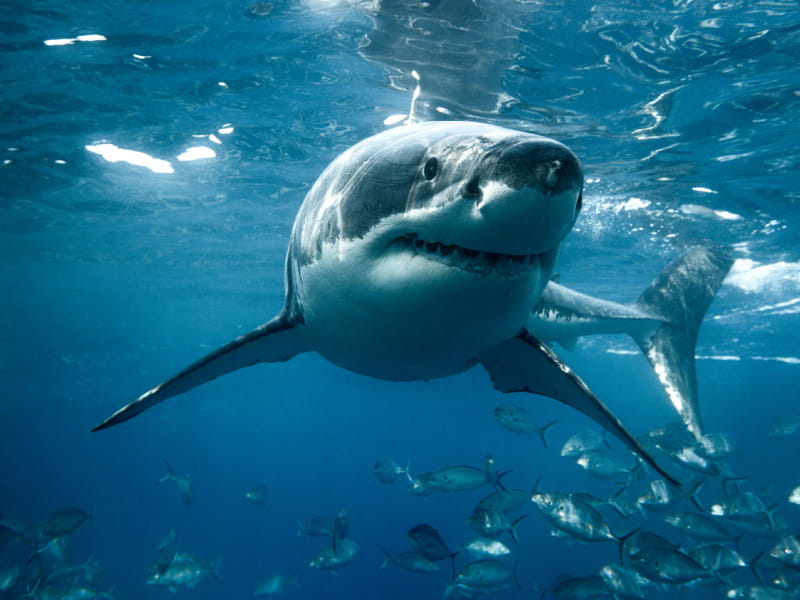What can sharks teach us about our hearts?
An odd question, we know.
At this time of year, sharks dominate our TV screens. The iconic heartbeat-like theme from “Jaws” – ba-dump, ba-dump – might make you wonder, “What could I learn about my own heart from a shark?”
Get ready to dive into this topic. “What can sharks teach us about our hearts?”
You might think sharks and humans have little in common regarding their hearts. Our last shared evolutionary ancestor lived 400 to 450 million years ago. Yet, shark hearts and human hearts share a fundamental similarity, says Dr. Georgina Cox, an assistant professor at Washington State University Vancouver. “Basically, the heart is a pump, no matter what species you look at.”
This pump doesn’t just deliver oxygen-rich blood, explains Cox, a comparative cardiovascular physiologist. “It unites all of our bodily systems,” helping remove waste and deliver hormones that enable organs to communicate.
Cox teaches human anatomy and biochemistry while studying fish cardiovascular systems and how they respond to stressors like increased temperatures and pollution. In both sharks and humans, the heart never stops beating. “And like us, if a fish’s heart stops working, that’s it,” she says.
Despite their functional similarities, shark and human hearts differ in structure, says Dr. Jules Devaux, a research fellow in the School of Biological Sciences at the University of Auckland.
Humans and other mammals have a four-chambered heart – two atria and two ventricles – that pumps blood to the lungs for oxygenation, back to the heart, and then out to the body.
Sharks, like other fish, typically have a two-chambered heart – one atrium and one ventricle. Inside a rigid, boxlike cavity, sharks also have a collection sac called the sinus venosus and a series of valves, the conus arteriosus, to keep blood flowing in the right direction. Blood is pumped to the gills for oxygenation before flowing to the shark’s body.
While the heart structures differ, sharks and humans share a unique feature: coronary circulation, says Cox, who wrote her doctoral dissertation on blood flow in shark hearts.
Sharks and humans have “fully vascularized” hearts. This contrasts with most bony fish species, which lack coronary arteries and rely on their hearts to absorb oxygen from blood that has already circulated through their bodies. Coronary arteries ensure a shark’s heart receives oxygenated blood directly from the gills.
In humans, coronary artery blockages can cause heart attacks, starving the heart of blood and oxygen, and killing heart muscle. Some sharks, however, have adapted to survive in low-oxygen environments. Devaux’s research includes work with epaulette sharks and grey carpet sharks, which live on coral reefs along the coasts of Australia and the Indo-Pacific region.
“These sharks prefer to inhabit the reef platform during low tide to avoid larger predator sharks,” he says. At night, when photosynthetic corals and algae stop producing oxygen, the water can become oxygen-poor, or anoxic.
The grey carpet shark can endure such waters for several hours by storing excess red blood cells, something akin to having a spare dive tank, says Devaux. The epaulette shark, also known as the “walking shark,” lacks this oxygen reserve and instead goes into a coma-like state. “Remarkably, it does so during nearly all nocturnal low tides, equivalent to surviving approximately five strokes per week without sustaining any brain or heart damage” from oxygen deprivation.
Devaux’s research focuses on mitochondria, the parts of cells that use oxygen to produce energy, and succinate, a substance that builds up during oxygen deprivation and converts into damaging “free radical” molecules when oxygen is reintroduced. The epaulette shark processes less succinate upon reoxygenation, reducing damage.
By understanding the mechanisms evolved by carpet sharks, “we may be able to offer innovative therapeutic strategies to help stroke and heart attack victims,” says Devaux. Understanding reperfusion, the reoxygenation process, is crucial, says Cox. “It’s both the lack of oxygen and the reperfusion that causes a lot of cardiac damage in humans.”
Cox studies hagfish, which are not sharks but can live in oxygen-poor waters, and leopard sharks, which don’t. She performs open-heart surgery on them to measure blood flow and understand the role of coronary circulation in the shark heart’s response to elevated ocean temperatures.
She jokes about never being in a shark cage. “They’re for wimps,” she says, quickly adding, “I’m just kidding.”
Her interest in shark hearts stems from a personal place. Her father survived both heart failure and a heart attack, and her career merges her interests in fish and the human heart.
While she isn’t aware of sharks having heart attacks, Cox doesn’t rule out the possibility. “They don’t come in for annual checkups. And usually when something goes wrong, they die, and then get eaten.” However, she notes that cutting off arteries that feed the heart muscle would be fatal for a human, while a fish can still absorb oxygen from blood that has circulated through its body. So a shark might survive a heart attack, Cox says.
Sharks get plenty of exercise and eat a balanced diet – key factors in preventing heart attacks and strokes in humans.
You might think sharks need constant movement, but not all do. They need water flowing over their gills, and tail muscle contractions help move blood back to the heart, much like walking helps return blood to the heart in humans.
The definition of a “balanced diet” varies by species. Most sharks are carnivores, eating animals that consume vegetables, thus breaking down nutrients. Humans, as omnivores, get nutrients from plants and animals, and research highlights the heart-health benefits of a plant-rich diet.
Some sharks have a taste for junk food, literally. “Some shark species will eat a suit of armor,” Cox says. “Just because they’re curious.”
Focusing on heart health is more beneficial than worrying about shark attacks. According to the Florida Museum of Natural History, the lifetime odds of dying from a shark attack are 1 in 4,332,817, compared to a 1 in 5 risk of dying from heart disease and a 1 in 24 risk of dying from a stroke. This is just an example answering the questions “What can sharks teach us about our hearts.”
Humans pose a greater risk to sharks than vice versa, through climate change, pollution, and fishing. Sharks, unable to maintain a steady body temperature, face increased oxygen needs as seawater temperatures rise, overloading their hearts. “It is the first organ to fail in fish exposed to acute marine heat waves,” says Devaux.
Humans also threaten sharks through pollution and fishing, either as accidental bycatch or intentional hunting for “weird remedies” with no medical basis, says Cox. “We are way more dangerous to them than they are to us.”
Despite this, sharks remain captivating and awe-inspiring, drawing millions of viewers each year. So, if you watch a show about a mako shark’s speed or a silky shark’s long-distance travel, remember you share a bit in common with them.
“The power you see in sharks, and their grace and beauty, results from a solidly working cardiovascular system,” says Cox.






Leave A Comment